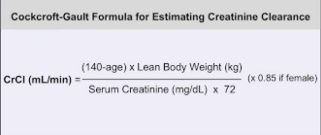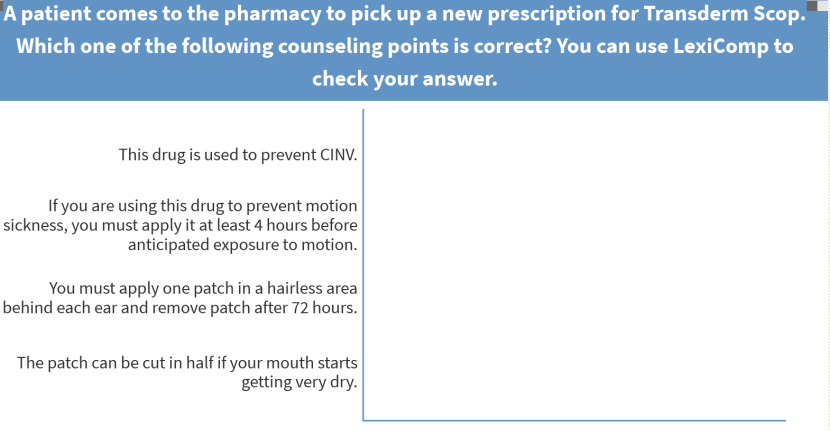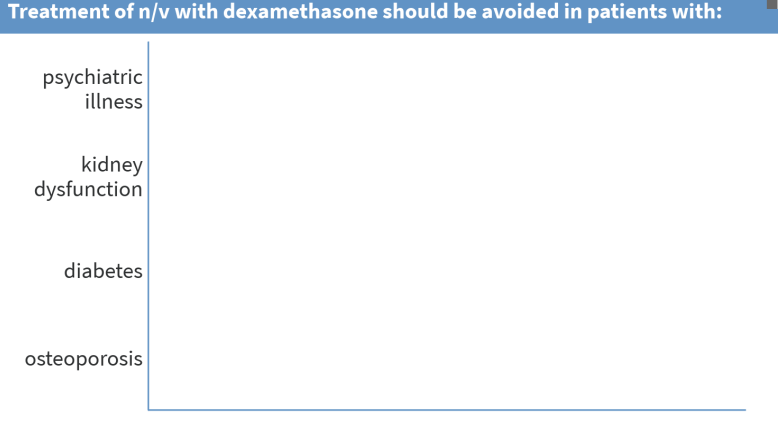LECTURE 5 - Pathophysiology and Pharmacotherapy of Nausea & Vomiting
1/99
There's no tags or description
Looks like no tags are added yet.
Name | Mastery | Learn | Test | Matching | Spaced |
|---|
No study sessions yet.
100 Terms
non-specific symptom
Drug-induced nausea/vomiting (n/v)
Anticipatory n/v
cock graft equation

3 consecutive phases of N/V
Nausea
Retching
Emesis
Simple N/V
Symptoms: self-limiting, resolves on its own
Signs: complaint of queasiness or discomfort
Laboratory tests: none
Complex N/V
Symptoms: not relieved after administration of antiemetics
Signs: weight loss, fever, abdominal pain
Laboratory tests: serum electrolyte
Upper/lower GI evaluation
Nonpharmacologic Interventions N/V
Dietary management
Acupressure, hypnosis, psychotherapy
For motion sickness: minimize exposure and magnitude of movement, restrict visual activity, ensure adequate ventilation
Pharmacologic Interventions for N/V
Treatment of simple n/v → OTC products
Treatment of complex n/v usually requires combination therapy with different pharmacologic mechanisms
Antacids
Place in therapy
(GERD)
heartburn
simple n/v
neutralizes gastric acid
Antacids
Use with caution
in patients with kidney dysfunction
Antacids
Adverse effects
diarrhea (magnesium)
constipation (aluminum and calcium)
H2-Receptor Antagonists (H2RA)
Famotidine (Pepcid®, Zantac 360®)
cimetidine (Tagamet®)
nizatidine (Axid®)
H2RA
Place in therapy
simple n/v associated with heartburn or GERD
H2RA
DDI
cimetidine
H2RA
adverse effects
Few adverse effects associated with this class of drugs
Motion Sickness and Vestibular Disturbances
Disturbances in the inner ear
Dizziness / vertigo
what does the vestibular system contain?
cholinergic and H1 receptors
what are anticholinergic and antihistamines are most commonly used to prevent and treat?
motion sickness
First line for motion sickness
Scopolamine patch prior to motion exposure
Anticholinergic and antihistamines
Adverse effects
drowsiness, reduced mental acuity, visual disturbance, dry mouth, urinary retention
Anticholinergics
Place in therapy
prevention and treatment of motion sickness
Some efficacy in preventing PONV
Scopolamine patch
dosage
1 mg/72 hours- apply 1 patch every 3 days
Anticholinergics
Adverse effects:
sedation, visual disturbance, dry mouth, dizziness

kidney dysfunction
Antihistamine-Anticholinergics
Diphenhydramine (Benadryl®, ZzzQuil®)
Dimenhydrinate (Dramamine® Original)
Meclizine (Bonine®, Dramamine® Less Drowsy)
Hydroxyzine (Atarax®)
Antihistamine-Anticholinergics
Place in therapy
motion sickness
vertigo
migraine headache
Antihistamine-Anticholinergics
Adverse effects
drowsiness, blurred vision, urinary retention, dry mouth seen mostly with first-generation antihistamines (diphenhydramine, dimenhydrinate, meclizine)
Second-generation antihistamines
cetirizine and fexofenadine
why are cetirizine and fexofenadine are ineffective?
it doesn't affect CNS
Postoperative Nausea & Vomiting
Common complication of surgery
Occurs within 24 hours of undergoing anesthesia
Patient risk factors for PONV
Female sex
Nonsmoking status
History of PONV
History of motion sickness
Anesthetic and surgical risk factors for PONV
Volatile anesthetics
Nitrous oxide
Intraoperative or postoperative opioids
Duration and type of surgery
High risk for PONV
2-3 prophylactic antiemetics (MEDS)
Moderate risk for PONV
1-2 prophylactic antiemetics (MEDS)
when are NK1 antagonists administered?
during induction of anesthesia
Postoperative Nausea & Vomiting
what do you give At the end of surgery?
Droperidol or haloperidol
5-HT3 receptor antagonist (ondansetron)
Steroids
Antihistamines
Anticholinergics
what medication has the best prevention for PONV ?
ondansetron
5-Hydroxytryptamine-3 Receptor Antagonists
Ondansetron (Zofran®)
Granisetron (Kytril®)
Dolasetron (Anzemet®)
Palonosetron (Aloxi®)
are all antacids Rx or OTC?
OTC
are H2-Receptor Antagonists (H2RA) Rx or OTC?
OTC
are anticholinergics Rx or OTC ?
Rx
are Antihistamine-Anticholinergics Rx or OTC
Rx: hydroxyzine and trimethobenzamide
the rest are OTC
are 5-Hydroxytryptamine-3 Receptor Antagonists Rx or OTC?
Rx
5-HT3 Receptor Antagonists
Place in therapy
complex n/v
prevention / treatment of PONV and CINV
5-Hydroxytryptamine-3 Receptor Antagonists
Adverse effects
headache
somnolence
diarrhea
constipation
QT prolongation
what medication should be used for acute and delayed CINV?
Palonosetron
what is the only 5-HT3-RA that doesn’t affect QT interval?
Palonosetron
is Dopamine Antagonist- Phenothiazines Rx or OTC?
Rx
Dopamine Antagonist- Phenothiazines
Promethazine (Phenergan®)
Prochlorperazine (Compazine®)
Chlorpromazine (Thorazine®)
Dopamine Antagonist- Phenothiazines
formulations
oral solids
liquids
rectal suppositories
parenteral
Dopamine Antagonist- Phenothiazines
Place in therapy
simple and complex n/v related to
motion sickness, vertigo, gastritis or gastroenteritis, NVP, PONV, CINV
Dopamine Antagonist- Phenothiazines
Adverse effects
sedation, orthostatic hypotension
EPS - can be seen in single-dose users as well as chronic users!
QT prolongation with prochlorperazine and chlorpromazine
Dopamine Antagonists- Butyrophenones
Droperidol (Inapsine®)
Haloperidol (Haldol®)
is Dopamine Antagonists- Butyrophenones Rx or OTC ?
Rx
Dopamine Antagonists- Butyrophenones
Place in therapy
limited use due to risk of adverse effects; preventing PONV
why is haloperidol used in palliative care ?
to reduce N/V
why is haloperidol used 2nd line?
for patients intolerant to first-line agents
Dopamine Antagonists- Butyrophenones
Adverse effects
sedation
agitation
restlessness
EPS
QT prolongation
Dopamine Antagonists- Butyrophenones
black box warning
QT prolongation
cardiac arrhythmias
are Dopamine Antagonists Rx or OTC?
Rx
Dopamine Antagonists
Metoclopramide (Reglan®)
Dopamine Antagonists
Place in therapy
complex n/v; PONV, CINV, NVP, diabetic gastroparesis, GERD
Increases lower esophageal sphincter tone
Promotes gastric motility (prokinetic)
Dopamine Antagonists
formulations
oral solid, oral liquid, and injectable
Dopamine Antagonists
Adverse effects
somnolence, reduced mental acuity, anxiety, depression, EPS, asthenia

apply one patch in hairless area behind EACH ear and remove patch after 72 hrs
are corticosteroids Rx or OTC ?
Rx
Corticosteroids
Dexamethasone (Decadron®)
also used in combination with other antiemetics
Corticosteroids
Place in therapy
complex n/v; prevention and treatment of PONV, CINV, radiation-induced n/v
Dexamethasone is effective in preventing acute/delayed CINV when used alone or with 5-HT3 receptor antagonists
Dexamethasone (Decadron®)
adverse effects
GI upset, anxiety, insomnia, hyperglycemia, fluid retention, psychosis (high doses), bone mineral density loss (chronic use)
are Cannabinoids Rx or OTC ?
Rx
Cannabinoids
Dronabinol (Marinol®)
nabilone (Casamet®)
C-III
Dronabinol
C-II
Nabilone
Cannabinoids
Place in therapy
Antiemetic and appetite stimulant activity - for cancer related pain
not first-line agents; prevention and treatment of refractory CINV
can Cannabinoids be used alone or with others ?
can be Used alone or in combination with other antiemetics
Cannabinoids
Adverse effects
sedation, euphoria, xerostomia, hypotension, ataxia, dizziness, vision difficulties
Cannabinoids
Route of administration
PO
Slow onset of action
types of Benzodiazepines
Lorazepam (Ativan®)
alprazolam (Xanax®)
BOTH ARE CIV
are Benzodiazepines Rx or OTC?
Rx
Benzodiazepines
Place in therapy
prevention and treatment of psychological n/v
are Benzodiazepines Weak antiemetic agents?
yes, usually used with combo
Benzodiazepines
Adverse effects
sedation and amnesia
respiratory depression occurs in high doses

osteoporosis
are Neurokinin-1 Receptor Antagonists Rx or OTC?
Rx
Neurokinin-1 Receptor Antagonists
Aprepitant (Emend®)
Fosaprepitant (Emend®)
Rolapitant (Varubi®)
Netupitant/palonosetron or NEPA for oral (Akynzeo®)
Fosnetupitant/palonosetron for injection (Akynzeo®)
Neurokinin-1 Receptor Antagonists
Place in therapy
preventing acute / delayed CINV
combined with 5-HT3 antagonist
Aprepitant
CYP3A4
an inhibitor and substrate of CYP3A4 → DDI
Rolapitant
CYP3A4
has no effect
is Dopamine Antagonist - Amisulpride Rx or OTC?
Rx
Dopamine Antagonist - Amisulpride
brand name
Barhemsys
Dopamine Antagonist - Amisulpride
Place in therapy
rescue PONV
pt failed other prophylactic antiemetic drugs
Dopamine Antagonist - Amisulpride
dosage form
IV
Doses differ between prevention and treatment
Dopamine Antagonist - Amisulpride
Adverse drug reactions
procedural hypotension, hypokalemia, increase serum prolactin, abdominal distension, pain at infusion site, chills
Nausea & Vomiting in Pregnancy
Affects majority of women
Must consider teratogenic potential of drug
Nausea & Vomiting in Pregnancy
Initial therapy
always nonpharmacologic (diet modification)
Nausea & Vomiting in Pregnancy
Pyridoxine (vit B6 )
Pyridoxine (vit B6 ) 10-25 mg 4x daily alone or + antihistamine
Hyperemesis gravidarum
mother may require IV fluid replacement with thiamine if weight loss occurred; reserve corticosteroids as last resort and avoid during the first 10 weeks
Hyperemesis gravidarum treatment
Ondansetron, metoclopramide, promethazine, corticosteroids
what happens when Corticosteroid use in the first trimester?
can cause oral clefts in the fetus
Nausea & Vomiting in Pregnancy
Monitoring
Severity of n/v
Change in patient weight
Number of vomiting episodes per day
Acid-base balance
Daily urine volume
Skin turgor (the skin’s elasticity)
Acid-base balance
electrolytes
BUN and creatinine